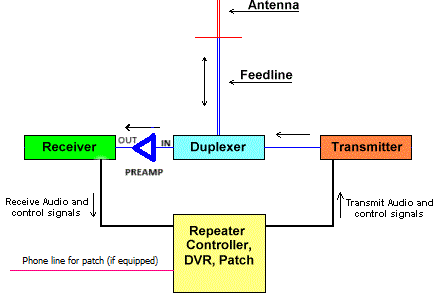Back to Home
By Mark A. Malm NØFAZ
with some additional help from Kevin Custer W3KKC

|
Up one level (Antenna Systems Index) Back to Home |
Receiver Preamps in Repeater Applications By Mark A. Malm NØFAZ with some additional help from Kevin Custer W3KKC |

|
In many situations, adding a preamp to the receiver of a repeater can increase its receive range and should "clean up" some of those noisy signals. Common thinking is that you can never make up for any signals that you are not receiving due to coax loss, connectors, etc. Thinking along these lines, one would assume that the more preamp gain you have, the better. Preamp gain is great for making up for loss between the antenna and receiver in a receive only situation, but on a repeater if the cable between the receiver and preamp is just a few feet, we do not need a lot of gain!
More gain does not always mean more range. Gain is not really the determining factor in how well a receiver hears. Although sufficient gain is necessary to overcome the losses (in filters and transmission line), Noise Figure (NF) is the real determining factor. Receiver noise figure is determined by a few things. First is the quality of the very first active stage, second is the amount of losses incurred ahead of it, and third is the bandwidth of amplification.
Too much gain can reduce the intermodulation specification of your repeater's receiver. This can be a real problem if you are on a site with other transmitters in the same band. In GE's MASTR II UHF service manual, intermod rejection drops 5 dB in the units equipped with the optional preamp!
So, the real reason a preamp adds sensitivity is because it lowers the receivers RF noise figure. However any losses in the receive path, before the preamp, add directly to the noise figure. The closer we can get the preamp to the antenna, the more it will help our system. But - we still need to protect the preamp from the repeater's transmitter and other emitters, so we can't put the preamp in the common path or eliminate too much filtering or the preamp will be damaged. Since it is not possible to place the preamp inline with the duplexed transmit/receive signal, we have two paths to choose from.
The first, and most common, is to add the preamp in the receive path between the duplexer and the receiver itself. An option here would be to place the preamp between two of the filters in our duplexer. This would allow us to make up for any of the losses in the filters and connectors following the preamps output, and reduce the losses ahead of the preamp somewhat (by moving it closer to the antenna) allowing for better noise figure. Again, since we are not making up for a great deal of loss, we do not need a lot of gain. This example works great in UHF systems but might be more difficult on 2 meters.
The second is to use separate antennas for transmit and receive, and place the preamp directly at the receive antenna. In this instance we would need to add some form of front end filtering to the preamp to protect it from being overloaded by other signals. This is the method the cellular folks use to get such fantastic range from those 0.6 watt portables (and some are half that)!
Most commercial two-way receivers have noise figures in the area of 10 dB. It is quite easy to find preamps with noise figures of 1 dB, or less. The goal is to realize the lower noise figure of the added preamp, without creating other problems. Different applications will require more or less gain, but a gain of 6 to 12 dB should be more than adequate for most installations. If you already have a preamp with more gain than you need, place a coaxial attenuator (pad) on its output port.
Masters Communications sells repeater (receive only) preamps that don't have a lot of gain to begin with, and work well for many ham and GMRS installations. These preamps have good return loss (match) that don't pull the duplexer's notch tuning off frequency like some preamps do. The last thing we want is to degrade the performance by adding gain and reducing the isolation.
I've done some testing with the Masters Communications P-Series preamps on converted MICOR receivers for 2 meters, 222, and UHF ham bands. On 220 I get .2 uV (-121 dBm) for 12 dB SINAD, an actual sensitivity improvement of 5 to 6dB. On 2 meters I have seen .15 uV (-124 dBm), about 9 dB of improvement over the .35 uV factory spec, and about the same on UHF. The stated gain is 13 dB or so, but you won't improve the the actual sensitivity by the amount of stated gain (at least not with this preamp on these type of receivers, as you are making up the difference between the receivers actual barefoot NF [about 10 dB] and the preamps' NF [about 2 dB].)
And remember, as long as the preamp does not get overloaded, the sensitivity of the receiver is above the noise floor of the site, and the NF of the preamp is less than that, the preamp will make an actual improvement on receiver sensitivity.

Back to the top of the page
Back to the Antenna Systems Index
Back to Home
This article is © Copyright November 19 1999 M. Malm NØFAZ
Hand-coded HTML © Copyright February 18, 2000 Kevin K. Custer W3KKC, all rights reserved.
This web page, this web site, the information presented in and on its pages and in these modifications and conversions is © Copyrighted 1995 and (date of last update) by Kevin Custer W3KKC and multiple originating authors. All Rights Reserved, including that of paper and web publication elsewhere.